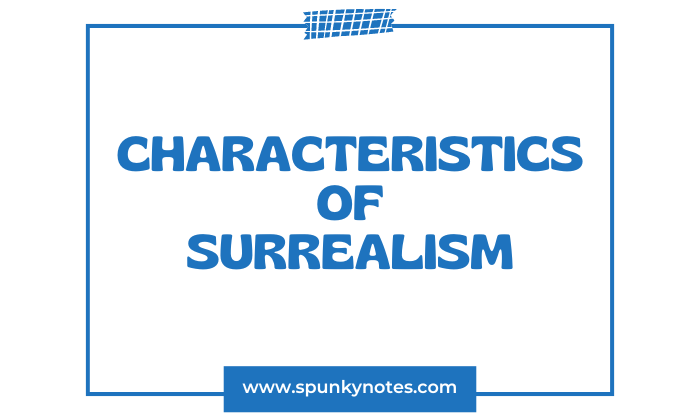
Q. Write down the characteristics of surrealism.
Surrealism
Surrealism is a cultural movement that began in the early 1920s. It is known for its unusual artworks and writings. The movement aims to combine dream and reality into a new form of truth known as “surreality.”
Artists and writers of Surrealism wanted to use the unconscious mind to unlock the power of imagination.
Historical Background
The movement started as a reaction to the rationalism that led to World War I. Surrealist artists believed that rationalism had caused much destruction.
They sought to break down the barriers between dreams and the real world. They were influenced by Sigmund Freud’s theories on dreams and the unconscious mind.
Key Figures
André Breton, often called the “Pope of Surrealism,” was crucial in starting and leading the movement. André Breton defined Surrealism as;
Psychic automatism in its pure state, by which one proposes to express—verbally, through the written word, or in any other manner—the actual functioning of thought.
Salvador Dalí is famous for his strange and eye-catching images. Max Ernst, René Magritte, known for his clever and thought-provoking images, and Joan Miró, colourful, abstract landscapes filled with dreamlike symbols, are other notable figures.
Techniques and Themes
Surrealist artists used various techniques to create their art. Automatism, chance effects, and dream interpretation were common. These techniques helped produce works that challenged the viewers’ perceptions and provoked curiosity or shock.
The themes often revolved around the unconscious mind, dreams, and the relationship between reality and imagination.
André Breton described Surrealism as a way of expressing the mind’s workings without careful thought, whether through words, writing, or any other form.
He suggested that artists should ignore logic and reach into their unconscious. This method, automatism or automatic writing, lets artists create without planning and welcomes unexpected results.
Sigmund Freud’s work, especially his book “The Interpretation of Dreams” from 1899, had a significant impact on Surrealists. Freud showed that dreams and the unconscious reveal true feelings and desires.
His ideas about hidden emotions, desires, and conflicts gave surrealism its foundation. Surrealist imagery is easy to recognize but hard to define because it varies significantly among artists.
Each artist used personal symbols from dreams or the unconscious. Generally, this imagery is strange, baffling, and unusual, aiming to surprise and challenge the viewer.
Characteristics of Surrealism
Surrealism is an artistic and literary movement that emerged in the early 20th century. It is characterized by the following characteristics that distinguish it from other art forms.
- Unconscious Mind
- Use of Dream Imagery
- Juxtaposition
- Elements of Surprise and Shock
- Automatism
- Liberation
- Psychoanalysis
1- Unconscious Mind
One of Surrealism’s main characteristics is its focus on the unconscious mind. Artists and writers believed the unconscious was a source of creativity and truth.
They used various techniques to access these hidden aspects of the mind, such as automatic writing and drawing, which involved creating without conscious thought.
2- Use of Dream Imagery
Surrealist works often include images and themes from dreams. This imagery is sometimes bizarre or illogical, reflecting the unpredictable nature of dreams.
Artists like Salvador Dalí created paintings that depicted dreamlike scenes, using precise and realistic techniques to paint unreal subjects.
3- Juxtaposition
Surrealism is known for its unexpected juxtapositions, which means placing unrelated objects or ideas close together surprisingly or shockingly. This technique creates new meanings and challenges the viewer’s perception of reality.
4- Surprise and Shock
Surrealist art often aims to surprise or shock the viewer. This can be through unsettling imagery, unexpected combinations of objects, or strange scenes that defy logic.
The goal is to provoke a reaction and make viewers question their assumptions about reality.
5- Automatism
Automatism is a process in which the artist suppresses conscious control over the making process, allowing the unconscious mind to have great sway.
This technique was believed to help artists break free from traditional artistic and societal constraints, leading to more innovative and original creations.
6- Liberation
Surrealism carries themes of liberation, both personal and societal. It sought to free individuals from the limitations of rational thought and conventional morality.
Surrealists believed that by tapping into the unconscious, people could achieve a higher state of freedom and understanding.
7- Psychoanalysis
The movement was heavily influenced by psychoanalysis, particularly the work of Sigmund Freud. Surrealists were interested in Freud’s theories about the unconscious and the significance of dreams.
Together, these features define Surrealism as a unique and revolutionary movement that has had a lasting impact on the arts.
6 English Surrealist Poets
1- Herbert Read (1893-1968)
Read actively supported Surrealism through his poetry and critical essays. He used Surrealist techniques in his poetry to explore the subconscious and provided insightful analysis of Surrealist art in his essays, establishing himself as a key figure in promoting Surrealism.
2- Hugh Sykes Davies (1909-1984)
As a British Surrealism pioneer, Davies experimented with language and Surrealist techniques to explore irrational and subconscious themes.
His innovative use of language reshaped 20th-century literary forms, making his work notable for its creativity and depth.
3- David Gascoyne (1916-2001)
Gascoyne played a key role in bringing Surrealism to the UK, blending French Surrealist thought with English literary traditions.
He explored the subconscious and criticized materialism in his work, highlighting his era’s philosophical questions and marking a significant cross-cultural literary exchange.
4- George Barker (1913-1991)
Barker’s Surrealism-influenced poetry features imagery and deep emotional exploration, especially concerning love and loss. His detailed images express emotions, showcasing his lifelong interest in the depths of human feeling.
5- Henry Treece (1911-1966)
Treece combined Surrealist elements with historical themes, using dreamlike imagery in his poetry. He often reimagined historical events with a poetic twist, offering a unique perspective by merging factual history with Surrealism’s imaginative aspects.
6- John Ashbery (1927-2017)
Ashbery’s poetry intersects modernism and postmodernism and draws on Surrealism. He is known for challenging traditional views on reality and perception with innovative narrative structures.

